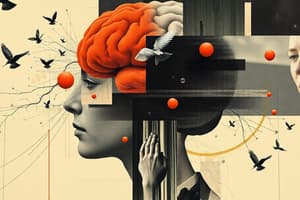Podcast
Questions and Answers
What effect does training on specific reaching activities have on rats?
What effect does training on specific reaching activities have on rats?
- Decreased synaptic transmission
- Reduced sensory feedback from the forelimbs
- Increased dendritic arborisation in the forelimb representation (correct)
- Diminished cortical mapping in the motor cortex
Which statement best describes long-term potentiation (LTP)?
Which statement best describes long-term potentiation (LTP)?
- It is the short-term enhancement of synaptic communication.
- It decreases the number of receptors on the postsynaptic cell surface.
- It results from stimulating two neurons simultaneously which enhances communication. (correct)
- It leads to a reduction in neurotransmitter sensitivity over time.
What does increased use of a body part correlate with in human studies?
What does increased use of a body part correlate with in human studies?
- Decreased sensory feedback
- Long-term degradation of synaptic connections
- Functional gain associated with training (correct)
- Static changes in the brain activity
Which of the following statements about synaptic plasticity is true?
Which of the following statements about synaptic plasticity is true?
How does mental practice influence plastic changes in the brain?
How does mental practice influence plastic changes in the brain?
What best defines the capacity of the central nervous system (CNS) regarding neuroplasticity?
What best defines the capacity of the central nervous system (CNS) regarding neuroplasticity?
What is a primary mechanism that enables neuroplasticity?
What is a primary mechanism that enables neuroplasticity?
Which statement about the nature of brain organization in neuroplasticity is true?
Which statement about the nature of brain organization in neuroplasticity is true?
How does training affect neural connections in the brain?
How does training affect neural connections in the brain?
What characterizes the dynamic nature of neuroplasticity?
What characterizes the dynamic nature of neuroplasticity?
Flashcards
Long-term Potentiation (LTP)
Long-term Potentiation (LTP)
The process of strengthening the connection between two neurons, making them more likely to communicate effectively.
Brain Plasticity
Brain Plasticity
Training can lead to changes in the brain's structure and function.
Neuroplasticity
Neuroplasticity
The ability of the brain to change its structure and function in response to experience.
Synaptic Enhancement
Synaptic Enhancement
Signup and view all the flashcards
Synaptic Communication
Synaptic Communication
Signup and view all the flashcards
What is neuroplasticity?
What is neuroplasticity?
Signup and view all the flashcards
Why is neuroplasticity important for rehabilitation?
Why is neuroplasticity important for rehabilitation?
Signup and view all the flashcards
How does neuroplasticity occur?
How does neuroplasticity occur?
Signup and view all the flashcards
What is the role of distributed brain organization in neuroplasticity?
What is the role of distributed brain organization in neuroplasticity?
Signup and view all the flashcards
How does training impact neuroplasticity?
How does training impact neuroplasticity?
Signup and view all the flashcards
Study Notes
Neuroplasticity Overview
- Neuroplasticity is the capacity of the central nervous system (CNS) to adapt to functional demands, leading to the system's ability to reorganise.
- Brain processes are continuously reshaped throughout life, primarily by the use of a system.
- This remodelling is a dynamic process, not a fixed structure.
- This includes changes in neural connections throughout life.
- The parallel and distributed nature of brain organization contributes to this flexibility and adaptability.
- Factors like training, increased use of a body part, and sensory feedback enhance plasticity.
Mechanisms of Neuroplasticity
- Neuroplasticity is enabled by neurochemical, neuroreceptive, and neurostructural mechanisms.
Cortical Mapping and Training Effects
- Training impacts the strength of existing neural connections, and the emergence of new connections.
- Training specific reaching activities in rats show increased dendritic arborization in motor and sensory cortices.
- This demonstrates functional changes in the brain (human and animal) due to training and use.
Long-term Potentiation (LTP)
- LTP is a long-term enhancement of communication between two neurons.
- This occurs from stimulating the neurons simultaneously.
- This enhances synaptic transmission.
- LTP improves the postsynaptic cell's sensitivity to neurotransmitters, mainly by increasing existing receptor activity and adding more receptors to the postsynaptic cell.
Long-term Depression (LTD)
- LTD weakens neuronal synapses selectively.
- This balance of LTP and LTD is necessary for constructive use of synaptic strengthening.
- This concept follows the phrase, "use it or lose it."
Silent Synapses
- Silent synapses exist in the nervous system.
Relationship Between Form and Function
- Altered form leads to altered function.
- Continuous demand on a cell contributes to a subsequent change in form.
Summary
- Humans adapt and reorganise throughout their lives in response to external demands.
- This plasticity is tied to structural and functional changes in the CNS.
- Training and using a body part, along with sensory feedback, enhances plasticity.
Studying That Suits You
Use AI to generate personalized quizzes and flashcards to suit your learning preferences.




